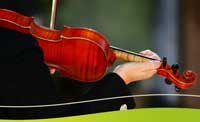What is the best way to protect the violin from extremes of temperature and humidity?
There is a lot of disagreement about whether the two items used to manage this problem are necessary: hygrometers measure humidity levels; humidifiers correct dryness.
Hygrometers in cases are either digital or analog (dial), and are not always accurate; in some cases the hygrometer has to be recalibrated regularly.
Sometimes there is a plastic vial (a humistat) which contains water and supplies humidity for the case. It clips in place somewhere down around the pegbox/scroll portion of the case and can be adjusted to allow more or less water vapor to escape.
If there is not one of these vials accompanying the hygrometer itself, you can purchase a humidifier to put in the f holes of the violin.
Both Strettos and Dampits seem to work well, although Dampits are more of a hassle since you have to resoak them frequently.
Many musicians keep a humidifier in the music studio (aim for a steady 50-60% humidity), which protects stringed instruments and pianos.
Certainly there are players who question the usefulness of these products and wonder whether any kind of humidification is a good idea for string instruments, in terms of avoiding cracks.
Humidifying an instrument in its case may be unnecessary except in extremely dry environments.
It's conceivable that too much humidity could cause problems with insects and otherwise damage the wood.
The constant changing of the moisture content of the wood can't be good for the instrument; if the maker has selected well seasoned wood, the best thing to do is let the instrument adjust to the prevailing humidity or lack thereof. For example: like Italy, Los Angeles is classed as a Mediterranean clime by geologists.
Violins sound better in L.A. then they do in the humidity of NYC, but players often don't have any problems- or use humidifiers.
Dryness may be good for fiddles - avoiding extremes, of course.
Connie Sunday: Freelance studio musician, strings and piano teacher, author of Violin FAQ and numerous essays in violin pedagogy. Further information can be found at connexions.
|

